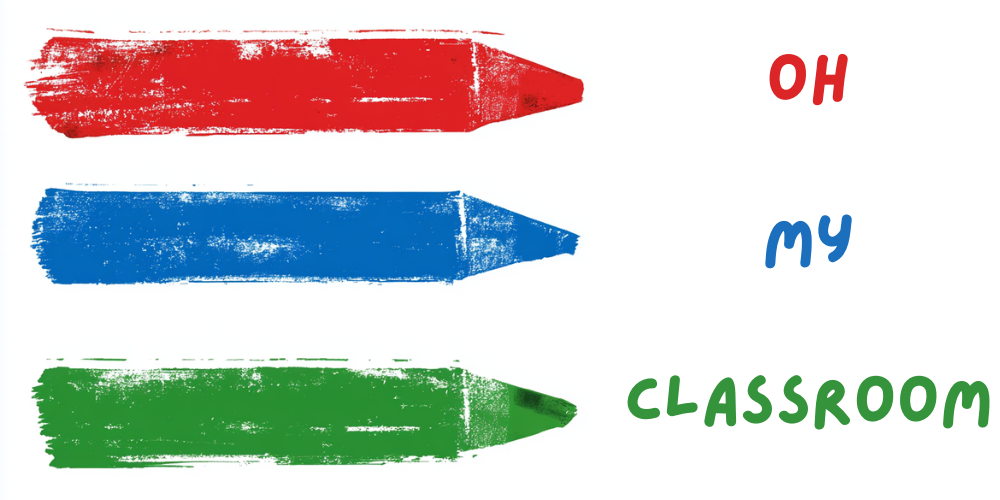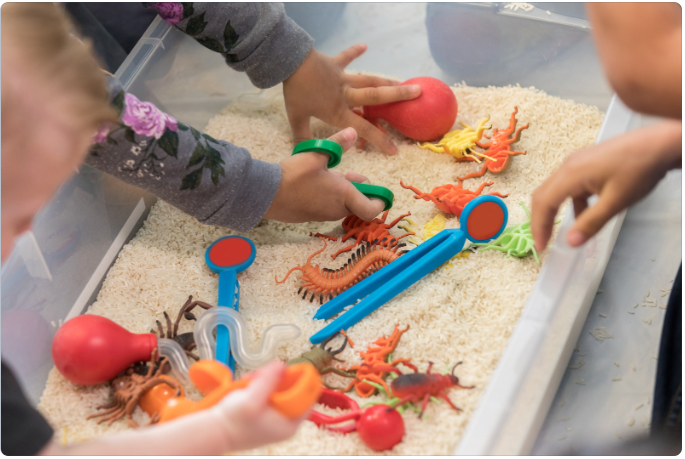Sensory play is an excellent way for children to engage their senses, explore different textures, and stimulate their cognitive development.
Rice sensory play is a popular and versatile option that provides hours of entertainment and learning opportunities. The smooth, grainy texture of rice can be soothing, and it offers endless possibilities for imaginative play.
Now, we will share creative rice sensory play ideas for kids.
Whether you’re looking for a simple activity to keep your child occupied or want to incorporate sensory play into their learning routine, these ideas are sure to inspire you.
From sensory bins to sensory bottles and more, there’s something here for children of all ages and interests.
So, get ready to dive into the wonderful world of rice sensory play and watch your child’s imagination soar as they explore these exciting activities.
Rice Treasure Hunt:
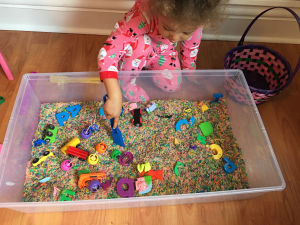
Transform a simple sensory play activity into an exciting treasure hunt by burying small objects or toys in a container filled with rice. Provide your child with a small shovel or their hands to dig through the rice and uncover the hidden treasures. This activity not only engages their sense of touch but also enhances their fine motor skills as they manipulate the rice to find hidden items. You can even add a competitive element by timing their treasure-hunting skills or encouraging them to find specific objects. It’s a delightful way to combine sensory exploration with the thrill of a treasure hunt.
Rainbow Rice Art:
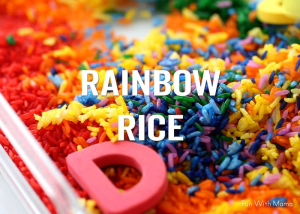
Bring vibrant colors to your rice sensory play by dyeing the rice in a rainbow of hues. Simply divide the rice into separate containers, add a few drops of food coloring to each container, and mix well until the rice is evenly coated. Once the colored rice is ready, provide your child with various tools such as paintbrushes, spoons, or even their fingers to create colorful masterpieces on a large sheet of paper. They can explore different textures, experiment with mixing colors, and unleash their artistic side in a mess-free and captivating way.
Related: 25 Social Studies Activities for Preschoolers
Rice Bin Construction Zone:
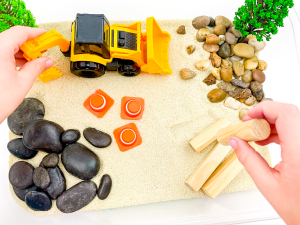
Turn a rice-filled sensory bin into a construction zone where your child can build and create to their heart’s content. Add toy trucks, construction vehicles, small blocks, and other building materials to the rice bin. Encourage your child to dig, scoop, and pour the rice to construct roads, buildings, or anything their imagination desires. This open-ended activity fosters creativity, fine motor skills, and problem-solving as they navigate through their miniature construction site. With rice as the base material, their construction projects are limited only by their imagination.
Rice Sensory Bottles:
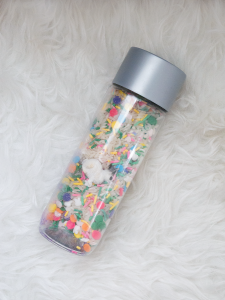
Create mesmerizing sensory bottles using rice and various small objects. Fill clear plastic bottles with different colored rice, along with items like sequins, beads, or small toys. Seal the bottles tightly and let your child explore the captivating sights and sounds as they shake and tilt the bottles. These sensory bottles provide a calming and stimulating experience, promoting visual tracking, focus, and sensory integration. You can even encourage your child to make their own sensory bottles, selecting the colors and objects they find most appealing.
Related: 20 Fun Sit Down Games for 3 – 7 Year Olds
Rice Sensory Letters:
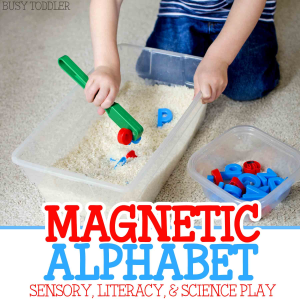
Combine sensory play with early literacy skills by creating sensory letters with rice. Use large letter cutouts or magnetic alphabet letters as a template and trace them onto colored paper. Apply glue within the traced lines and sprinkle rice over the glue to create textured letters. Once the glue dries, your child can run their fingers over the rice-textured letters, feeling the grainy texture while also learning letter recognition. This activity adds a tactile element to letter learning, making it engaging and interactive for young learners.
Rice Sensory Bin with Tools:
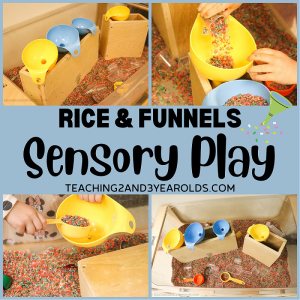
Create a sensory bin filled with rice and provide your child with various tools such as spoons, scoops, funnels, and measuring cups. Let them explore the different ways they can manipulate the rice using these tools. They can pour, scoop, and transfer the rice from one container to another, engaging their fine motor skills and hand-eye coordination. Encourage them to experiment with different techniques and observe how the rice behaves when they pour it or scoop it using different tools.
Rice Sensory Play with Scented Rice:

Enhance the sensory experience by adding a delightful scent to the rice. You can achieve this by mixing a few drops of essential oil or food extracts into the rice before playtime. The aroma will stimulate their sense of smell as they explore the rice. Consider using scents like lavender, vanilla, citrus, or even peppermint for a refreshing twist. Scented rice sensory play not only engages multiple senses but also provides a calming and soothing effect.
Rice Sensory Bin with Hidden Numbers or Letters:

Incorporate learning into rice sensory play by hiding numbers or letters within the rice bin. Write or print out numbers or letters on small cards or foam pieces and bury them in the rice. Provide your child with a small shovel or their fingers to dig through the rice and find the hidden cards. As they discover the numbers or letters, encourage them to identify and match them to their corresponding counterparts. This activity promotes letter or number recognition and adds an element of excitement to the sensory play experience.
Rice Sensory Play with Small Toy Animals:

Create a rice-filled sensory bin and add small toy animals like dinosaurs, farm animals, or jungle creatures. Your child can bury the animals in the rice, mimic their sounds, and create imaginative scenarios. They can dig them out, arrange them in different ways, and engage in pretend play, fostering their storytelling abilities and creativity. This activity encourages tactile exploration, imaginative play, and animal recognition.
Rice Sensory Play with Sorting and Counting:
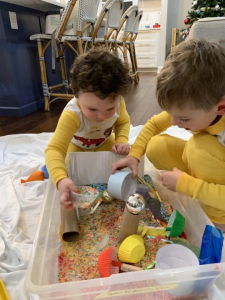
Promote early math skills by incorporating sorting and counting into rice sensory play. Provide your child with small objects like buttons, pompoms, or colored beads, and encourage them to sort the objects by color, shape, or size using the rice as a sorting base. They can also practice counting by placing a certain number of objects in the rice and then counting them as they retrieve them. This activity strengthens their sorting, categorization, and counting abilities while providing a hands-on and enjoyable learning experience.
Rice Sensory Play with Magnetic Letters:
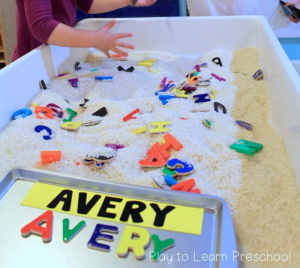
Introduce literacy skills and magnetic play into your rice sensory activity by adding magnetic letters to the mix. Fill a sensory bin with rice and bury magnetic letters within it. Provide your child with a magnetic wand or fishing rod with a magnet attached, and encourage them to go on a letter-finding adventure. As they locate the magnetic letters, they can match them to a magnetic surface or spell out simple words. This activity combines sensory exploration, fine motor skills, and early literacy development in a playful and interactive way.
Rice Sensory Play with Rice Pounding:
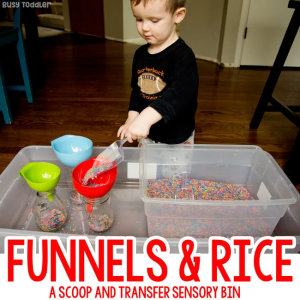
Engage your child’s gross motor skills and sensory exploration with a rice pounding activity. Fill two large containers or bins with rice and place them side by side. Provide your child with toy hammers or wooden mallets and encourage them to pound the rice in one bin, transferring it to the other. The rhythmic pounding and the sensation of the rice grains will offer a satisfying sensory experience. This activity also helps with hand-eye coordination, concentration, and release of excess energy.
Rice Sensory Play with Rice Art Patterns:
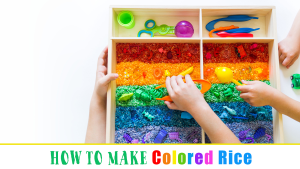
Combine sensory play with artistic creativity by using colored rice to create patterns and designs. Prepare different colors of rice by dyeing them with food coloring or liquid watercolors. Provide your child with a large tray or a flat surface and encourage them to arrange the colored rice in patterns, such as stripes, circles, or even simple shapes. They can experiment with different colors, textures, and spatial arrangements, allowing their creativity to flourish. This activity promotes fine motor skills, visual-spatial awareness, and artistic expression.
Rice Sensory Play with Rice Writing Tray:
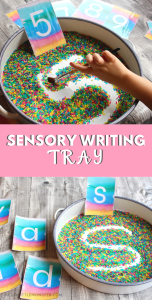
Create a sensory writing tray using a shallow container filled with rice. Encourage your child to use their fingers or a small writing tool (e.g., a chopstick or paintbrush) to draw letters, shapes, or even their name in the rice. They can feel the texture of the rice as they trace their fingers through it, reinforcing letter formation and pre-writing skills. This activity provides a tactile and engaging way to practice writing while stimulating sensory exploration and hand-eye coordination.
Rice Sensory Play with Rice Bin Construction Site:

Transform your rice sensory bin into a bustling construction site by adding toy construction vehicles, small plastic cones, and building blocks. Encourage your child to use the rice as a base for their construction site and create roads, bridges, and buildings using the materials provided. They can use construction vehicles to dig, scoop, and transport the rice, simulating real construction work. This activity promotes imaginative play, fine motor skills, and spatial awareness as they build their own miniature world.
Rice Sensory Play with Rice Pouring and Transferring:
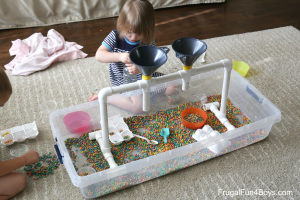
Create a pouring and transferring station by setting up containers filled with rice and providing various tools such as cups, spoons, funnels, and scoops. Encourage your child to pour, scoop, and transfer the rice between different containers. They can experiment with different pouring techniques, observe how the rice flows, and refine their motor skills as they manipulate the tools. This activity stimulates hand-eye coordination, concentration, and sensory exploration while offering a satisfying sensory experience.
